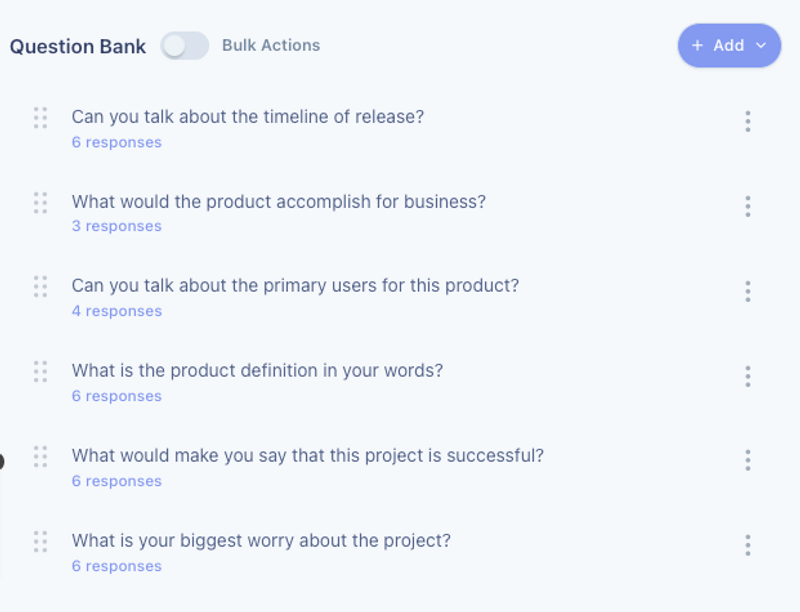
7 Things Not to Do During a User Interview
Conducting high-quality user interviews goes beyond just being confident in your people skills.
At UserBit, we believe in empathy and creating a space for open and authentic user expression, whether online or in person. And as interviewers, it's our job to set the tone.
But hey, even if you pride yourself on being an observant and empathetic researcher, there’s always room to be even more vigilant and proactive when preparing for your future interviews.
Below, we outline seven key mistakes to steer clear of so you can ensure the interview insights you gain are everything we cherish about our qualitative data: productive, relevant, and free from bias. Here we go:
1. Showing up unprepared
Alright. Let's pause for a quick moment and envision this scenario…
You're starting a user interview and suddenly, you realize your recording equipment isn't working.
You're at a loss about who your interviewee is without your notes, and frustratingly, those notes are nowhere to be found.
As you frantically search through papers for your questions, the clock is ticking, and your interviewee is sitting there, waiting and watching... It’s awkward, to say the least!

What's the problem here? Well, for starters, this disorganized start not only creates an uncomfortable atmosphere but also eats into your valuable interview time.
Being unprepared can jeopardize your chances of establishing a meaningful connection right from the beginning.
Plus, your participant, sensing the confusion, might feel overlooked or start doubting the effectiveness of the interview.
Our advice to dodge all this potential chaos? Prepare every single time by testing your equipment beforehand and familiarizing yourself thoroughly with your participant's background.
For example, get the following information straight (maybe with our notes section 😉), before you go into any user interview:
- Why are they here?
- Is it your first time meeting each other?
- Are they with another company or independent?
- What have they mentioned about your product or service?
- What other similar products or services do they use?
Going in prepared will give you an opportunity to develop rapport with your participant and help you tailor your questions more effectively so you’ll have a focused discussion.
Also, come with a list of questions. Having a structured set of questions will guide the conversation smoothly so you can go over several of your participant's experiences and perspectives in the given time.
Tip: Consider using a participant management tool that’ll keep all essential details about your participants – their history, background, company – neatly organized and easily accessible.
2. Recording the conversation without asking permission
We know, it might seem like common sense, but there are times when you might get so engrossed in the conversation or find your participant so easygoing that you forget to get their consent to record the chat.
Big mistake!
Not only is asking for recording permission essential for complying with legal requirements, but it's also a matter of respecting their personal boundaries.
To show professionalism and respect for your interviewee's rights, always make it a point to ask them for explicit permission, even when it's solely for internal use within your team. Letting your interviewee know the purpose behind the recording, such as internal analysis or team improvement, can also help build trust.
So, no matter how smoothly the conversation is going, don't skip the step of asking for the official go-ahead before you hit that record button.
3. Allowing others to observe the live interview
While it's perfectly natural (and encouraged) to share your recorded videos, transcriptions, and insights with colleagues or stakeholders after an interview, please do consider the impact of letting others in on live interviews.
When external parties observe a live interview, be aware that your participant's behavior can change. They may feel under scrutiny or anxious about their responses which can lead to potentially biased or inaccurate insights.
The Hawthorne effect is a type of reactivity in which individuals modify an aspect of their behavior in response to their awareness of being observed.
This shift in behavior is often due to the presence of observers creating a power dynamic where your participant may perceive themselves as being evaluated or judged. As a result, they may be less inclined to share negative feedback or criticism.
To conduct a successful user interview, we recommend limiting the number of observers and inform your participant in advance if others (such as a note-taker) will be present. Alternatively, you could try conducting separate debrief sessions with observers after the interview to discuss findings and avoid potential biases.
Since the goal is to create a comfortable and open space for your participant to share their thoughts and experiences honestly, be mindful of who's in the room or on the call — and their specific roles.
4. Priming the participant
It's a well-known fact that human beings are influenced by the information presented to them before an event.
This psychological phenomenon is known as “priming”, and it can significantly impact the results of your user interviews. When you provide too much information or set certain expectations before an interview, you can inadvertently "prime" the participant.
This means you're influencing their responses based on what they think you want to hear. In most situations involving the design process and moving users through our user interface (UI), we’re big fans of priming. But in an interview? You’ll likely end up with biased or inaccurate answers.
To keep your user interviews on the straight and narrow, avoid priming by keeping your pre-interview information minimal, and don't reveal your expectations.
For example, instead of saying, "We're looking for positive feedback on our new website design," you can start by asking, "Please tell us about your experience using our website." Keeping a neutral stance will encourage your participant to provide unfiltered feedback that’s free from priming influences.
5. Asking badly-designed questions
One of the keys to conducting effective user interviews is asking well-designed questions that encourage open and honest responses.
However, there are common types of questions that are no bueno and we recommend staying away from during a user interview:
Closed questions
These are questions that can be answered with a simple "yes" or "no" or with very limited options. Why’s that? They restrict your participant's ability to provide detailed or nuanced responses.
For example, asking, "Do you like our website?" or “Did you find the website easy to navigate?” are closed questions that limit your participant's response and don't encourage them to elaborate on their experience.
Hypothetical questions
Hypothetical questions ask participants to speculate or imagine scenarios that may not reflect their real experiences. These questions can lead to responses that aren’t grounded in reality and are hard to imagine.
For example, asking, "How would you feel if the website had a different color scheme?" is a hypothetical question that doesn't address your participant's actual experience.
(As a best practice, consider having a prototype in place for testing if such a scenario arises so participants can provide feedback based on a tangible experience rather than speculations.)
Bottom line? To ensure your user interviews yield valuable insights, focus instead on crafting open-ended, well-phrased questions that encourage participants to share their genuine thoughts and experiences.
Rather than asking closed or hypothetical questions, aim for questions that begin with "How," "Why," or "Can you tell me about..." to stimulate meaningful discussions.
begin with "How," "Why," or "Can you tell me about..." to stimulate meaningful discussions.
Here are some examples of open-ended questions (ones that we’ve asked our own participants on UserBit!):
- Tell me about your experience using our product/service.
- Can you tell me what your main goals or objectives are when using our product/service?
- Can you walk me through how our product/service fit into your daily workflow or routine?
- In your own words, what improvements or changes would you suggest for our product/service?

6. Asking more than one question at a time
Have you ever been in a conversation where someone fires multiple questions at you without giving you a chance to respond?
It can feel like a rapid-fire round, and we've all been guilty of this at some point.
It’s okay if it happens occasionally, but the key is to recognize it and take a step back.
For example, imagine asking a participant, "What do you think of our website layout, and can you easily find the information you need? Also, when was the last time you visited our mobile app, and what tasks did you perform?"
Being suddenly bombed by these questions can overwhelm your participant and lead to fragmented responses.
Instead, adopt a more user-friendly approach by asking one question at a time so your participant has the space to fully express their thoughts.
For instance, start by asking, "What are your impressions of our website layout?" Listen actively to their response, and when appropriate, introduce follow-up questions gradually. Slow and steady wins the race!
7. Telling a participant that their answer is right or wrong
Last but certainly not least, let’s avoid giving value judgements. UX professionals and researchers like ourselves should always remain neutral and avoid passing judgment on participants' responses.
What’s an example of a value judgment, you might ask? Consider the impact of saying, "That's a great insight, you're absolutely right!" or, conversely, "Hmm, that's not quite what we were looking for." Such responses can unintentionally steer the conversation and hinder participants from freely sharing their thoughts.
Instead, emphasize neutrality and openness throughout your interviews. Encourage participants to express themselves freely by responding with phrases like, "Thank you for sharing your perspective," or "I appreciate your insights."
By doing so, you create a safe and non-judgmental space where participants feel valued and can provide candid feedback.


